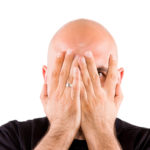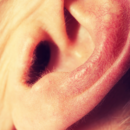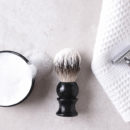
Having hairy ears might not be a good sign–and not only because it’s quite unsightly.
According to a 2006 study, there’s actually a link between having hairy ears and heart attacks.
Sounds a bit scary, doesn’t it? Apparently, physicians have been noting a link between heart health and ears for years.
So, there it is. If you didn’t have any motivation to get rid of your ear hair, now you have.
So get those tweezers and trimmers out and sort out your hairy ears right away. You never know. It could help save your life.
Want to know how to remove ear hair? Please follow this guide for more information.
What Causes Hairy Ears?
Extra ear hair is one problem that mostly affects men, as they grow older and hormone levels in their body change.
Ear hair can sprout from the ear canal in bunches, or randomly grow on different areas of the ear. It can cause hearing problems if it gets too thick, and ear wax in the hair may cause hygiene issues.
Ear hair removal methods include scissors, tweezers, trimmers, and chemicals.
Doctors have no idea why some of us have so much ear hair. For years, researchers thought ear hair was a hereditary trait, passed through the Y chromosome. However, studies done more recently have disproved this theory.
It’s rare for someone to have long hair on the outer ear. However, it’s most common among Indian and Sri Lankan men.
While it’s rare, babies born to diabetic women can have hair in their ears. Studies show that women who control their diabetes better while they’re pregnant are less likely to give birth to babies with ear hair.
There’s also hypertrichosis, a condition where hair grows on the whole body. Most cases aren’t genetic, but some are. Other causes include:
- Disorders of the endocrine or metabolic system
- Certain medications
- Poor nutrition
- Inflammatory or infectious skin conditions
- Abnormal growths in the adrenal glands or ovaries
Hereditary hypertrichosis normally happens alongside another condition, such as epilepsy, body malformations, or disability.
Excess hair inside the ear canal can increase your risk for swimmer’s ear, also called otitis externa. This is an outer ear infection.
You can develop the condition when bacteria and water are trapped and the bacteria multiply. More hair gives the slime more areas to get stuck.
How to Remove Ear Hair
Hairy ears won’t lead to any serious health conditions, but if you hate their feel or look, you can do something about it. You’ve got several options.
Shaving/Trimming
If you can’t stand any kind of pain in the extremely sensitive ear canal, you’ve got all sorts of solutions which can easily remove hair in your ears without burning anything or getting rid of the root.
There are specially designed scissors for sniping ear hair, and there are trimmers with special blades to trim the hairs in the ear canal. While shaving or trimming doesn’t produce permanent results, it’s absolutely pain-free!
Plucking/Tweezing
If you’re a tough-as-nails manly man, you certainly don’t dread the prospect of violently plucking the hair out of your ears by the root, one after the other.
For the less manly men, plucking is a very painful method that works quite well. So long as you’re able to see your ear hair, you can pull it out. However, tweezing or plucking is going to be difficult if the hair is inside your ear.
Depilatory Creams
Depilatory creams are the perfect solution for those looking for the least uncomfortable method. They have chemicals that make the hair vanish and retard the growth of hair for a significant period of time.
Be careful not to use these creams on warts, breakouts, wounds, or scars though. Always test the cream on tender skin to know if it’s suitable for you. Any sort of irritation or discomfort would indicate its unsuitability.
Laser Hair Removal
If you’re really determined to deal with your hairy ears, laser hair removal can be a great solution as it’s currently considered the best option.
While it won’t give you the long-lasting results that electrolysis can, the risk of ear damage is much less.
Of course, this doesn’t mean that laser hair removal is painless, but it’s a little safer than electrolysis. Laser hair removal can give you a few years of hair-free ears, so it’s worth trying out.
Waxing
Waxing the ear canals may look like a bizarre option, but the fact is that it may be done quite easily. Your ear canal is cleaned thoroughly before baby powder is applied inside the ear.
A Q-tip dipped in wax is placed inside the ear, and the wax is yanked out when it cools well enough to stick to the hairs. Waxing is an effective method to remove ear hair, but it’s got a higher risk of infection and damage.
Electrolysis
This technique involves a minuscule needle being placed inside hair follicles, with electricity passing through this needle to burn ear hair.
Given that it treats a small area, electrolysis is arguably the most popular ear hair removal technique for those looking for a permanent solution.
Burning
Originally from Turkey, this method is catching on in the US though it’s only a few specialists currently practicing it.
The barber wraps a cotton ball around a pair of scissors, and dips it in special alcohol. He or she then sets the cotton ball on fire and taps it against the ears. The hairs are burnt by the fire, leaving a hair-free skin.
Burning is a special treatment but it can be quite painful if not done right.
Get Ready to Remove Ear Hair
Considering all of the above options, you really don’t have any reason not to finally remove those ugly ear hairs. All in all, it really matters little what technique you choose so long as you take steps to fix the problem.
If you need more information on effective ways to fix hairy ears, make sure to check out our blog. We delight in helping men choose the best ways to remove ear hairs.
Feeling more adventurous? You might want to check out our post on manscaping to learn how to shave yourself down there without cutting yourself.

























